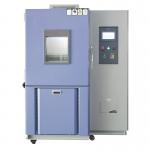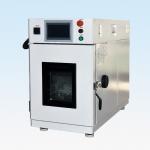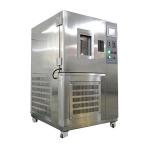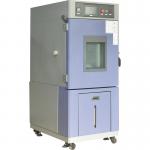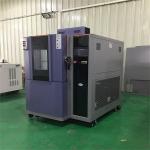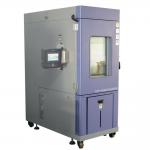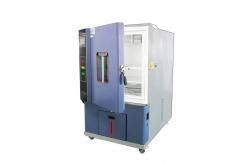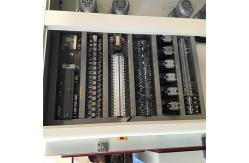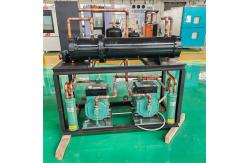In the burgeoning field of solar energy, the reliability and
performance of photovoltaic (PV) modules are of paramount
importance. The Customization Temperature Environmental Test
Chamber for Photovoltaic Module is a specialized piece of equipment
that plays a crucial role in ensuring the long-term viability and
efficiency of solar panels. This custom-designed chamber is specifically engineered to subject
photovoltaic modules to a wide range of temperature conditions. It
serves as an essential tool for PV module manufacturers, research
institutions, and quality control laboratories. The primary purpose
is to evaluate how PV modules perform and degrade under different
temperature stresses, replicating the extreme heat and cold they
may encounter during their operational lifespan. By simulating
these real-world scenarios, manufacturers can identify potential
weaknesses in their module designs, optimize manufacturing
processes, and ensure that their products meet or exceed industry
standards and customer expectations. - Robust and Heat-Resistant Construction
- The chamber is constructed with a heavy-duty framework, typically
made of corrosion-resistant steel, to withstand the rigors of
continuous testing and the high temperatures involved. The interior
is lined with a heat-reflective and non-reactive material, such as
a specialized ceramic coating or high-temperature-resistant
polymer, to minimize heat absorption and prevent any interaction
with the PV modules. The insulation is of top-notch quality,
ensuring minimal heat transfer to the external environment and
maintaining precise temperature control. The door of the chamber is
designed for a tight seal, featuring a reliable locking mechanism
and a high-temperature gasket. It also includes a large viewing
window, usually made of heat-strengthened glass with anti-fog and
anti-scratch properties, allowing for continuous visual monitoring
of the testing process without compromising the internal
temperature conditions.
- Precision Temperature Control Systems
- Temperature Range: The temperature control system is highly
accurate and can maintain a wide temperature range, typically from
-40°C to +100°C, which covers the typical temperature extremes that
PV modules may experience in various climates. The accuracy of the
temperature control is within ±0.3°C, ensuring that the slightest
temperature variations are precisely regulated. The system utilizes
advanced refrigeration and heating technologies, along with a
sophisticated feedback loop and multiple temperature sensors
strategically placed throughout the chamber. This ensures uniform
temperature distribution across the PV module, which is crucial for
obtaining accurate and reliable test results. The system also has
built-in safety features to prevent overheating or overcooling,
protecting both the PV modules and the chamber itself.
- Programmability: The chamber's control panel is highly
programmable, allowing users to create and store complex
temperature profiles. This enables the simulation of a wide variety
of environmental conditions, such as daily temperature cycles,
seasonal temperature changes, or rapid temperature fluctuations.
For example, it can mimic the temperature variations that a PV
module might experience in a desert environment during the day and
night or in a high-altitude region with significant temperature
differences. The control panel is user-friendly and intuitive, with
a clear display that shows the current temperature, the set
temperature profile, and the status of the testing program.
- Advanced Instrumentation and Data Acquisition
- The chamber is outfitted with a comprehensive suite of sensors.
Temperature sensors are distributed evenly to detect any
temperature gradients and ensure a homogeneous thermal environment.
These sensors are connected to a state-of-the-art data acquisition
system that records and stores all the measured data. The data can
be accessed and analyzed in real-time or retrieved later for
in-depth studies. The data acquisition system is highly flexible
and can be integrated with external software and databases,
facilitating seamless data transfer and analysis. It can also be
configured to send notifications and reports automatically, saving
time and effort for the users. Additionally, the control panel
includes built-in alarms and safety features that alert users in
case of any abnormal conditions, such as temperature excursions
outside the set limits, power failures, or equipment malfunctions.
- Volume and Dimensions: The chamber is designed to accommodate different sizes of
photovoltaic modules, with interior dimensions that can be
customized based on the specific requirements of the user. The
volume typically ranges from a few cubic meters to larger sizes,
depending on the scale of testing. The external dimensions are
configured to fit within a standard laboratory or production
facility space, taking into account factors such as access,
ventilation, and clearance.
- Temperature Uniformity: The temperature uniformity within the chamber is maintained
within ±0.5°C. This ensures that all parts of the PV module
experience a similar thermal environment, which is essential for
accurate testing. Even a slight temperature difference across the
module can lead to different performance outcomes and inaccurate
assessment of its durability.
- Stability: The temperature stability is excellent, with minimal fluctuations
over time. This allows for long-term testing and the evaluation of
a PV module's performance under stable temperature conditions, as
well as its ability to withstand temperature changes over extended
periods. The chamber is designed to maintain a constant temperature
within a very narrow range, ensuring the reproducibility of test
results.
- Accurate Simulation of Temperature Conditions
- The primary function of this chamber is to provide a highly
accurate and realistic simulation of specific temperature
conditions. By precisely controlling the temperature, it allows
manufacturers to evaluate how PV modules will behave in various
real-world situations. For example, in hot desert regions, high
temperatures can cause a decrease in the efficiency of PV modules
and potential degradation of their components. By testing modules
in the chamber under such conditions, manufacturers can develop
strategies to mitigate these effects, such as improving the thermal
management of the modules or using more heat-resistant materials.
- The ability to create complex temperature profiles, such as cyclic
temperature changes, is also a valuable function. This can help in
understanding how PV modules will respond to the changing
temperature conditions they may encounter throughout the day and
over the seasons. For instance, a module that is exposed to daily
temperature cycles may experience stress-induced damage over time,
and this chamber can accurately replicate such scenarios to
determine the module's durability and performance over its
lifespan.
- Enhanced PV Module Quality and Reliability
- Through comprehensive testing in the chamber, manufacturers can
identify and address potential issues in their PV module designs.
If a module shows signs of degradation or performance reduction
under specific temperature conditions, appropriate measures can be
taken, such as modifying the cell layout, improving the
encapsulation materials, or enhancing the heat dissipation
mechanisms. This leads to the development of more stable and
reliable PV modules, reducing the risk of failures and increasing
the overall efficiency and lifespan of solar power systems. It also
helps in optimizing product warranties and service intervals, as
manufacturers have a better understanding of the module's
durability under different temperature stressors.
- The test chamber also serves as a powerful tool for research and
development. It allows scientists and engineers to study the
effects of temperature on new PV materials and module designs. For
example, in the field of PV research, the chamber can be used to
investigate the behavior of emerging semiconductor materials under
different temperature conditions, leading to the discovery of new
materials with improved performance and durability.
- Compliance with Industry Standards and Regulations
- The photovoltaic industry is highly regulated, and there are strict
standards regarding the testing of PV modules under specific
temperature conditions. The Customization Temperature Environmental
Test Chamber for Photovoltaic Module is a reliable tool for
ensuring compliance. For example, international standards such as
IEC 61215 require PV modules to undergo temperature cycling tests
to evaluate their durability. By using this chamber to conduct
tests in accordance with relevant standards, manufacturers can
prove that their products meet the necessary criteria, facilitating
market access and enhancing consumer confidence. Regulatory bodies
rely on accurate test results obtained from such chambers to
enforce safety and quality regulations.
- Stringent Manufacturing Process
- The Customization Temperature Environmental Test Chamber for
Photovoltaic Module is manufactured under strict quality control
procedures. Each component, from the insulation panels to the
temperature control systems, is carefully sourced and inspected for
quality and performance. The assembly process is carried out by
highly trained technicians in a clean and controlled environment,
ensuring the proper installation and functionality of all parts.
- The calibration of the temperature sensors and control systems is a
critical and regular part of the manufacturing process. It is
performed using traceable reference standards to guarantee the
accuracy and reproducibility of the test results. Rigorous quality
audits and inspections are conducted at various stages of
production to maintain the highest level of product quality.
|
